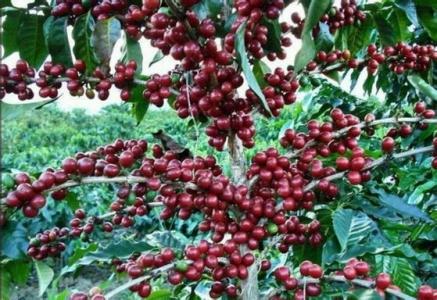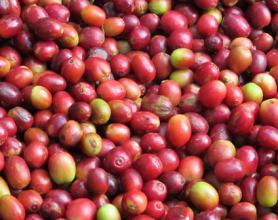Flavor description of South Minas Coffee Bean in Brazil Variety Grinding scale
Flavor description of South Minas Coffee Bean in Brazil Variety Grinding scale
Based on the drier climate in Brazil, research units in Brazil have developed a half-sun method to shorten the treatment time. After removing the pulp, the coffee fruit will be exposed to the pectin-coated pods for one to three days, and then machine-dried to a moisture content of 12%, which can be put into a storage container. The Brazilian half-sun method greatly shortens the work time (the traditional sun method takes two to three weeks), also reduces the chance of coffee beans getting a bad smell, and the quality is greatly improved. Moreover, the half-sun method also inherits the advantages of the sun method to improve the sweetness, but reduces the thankless soil flavor, and enhances the fruit aroma and sweetness, so it is most suitable for a single product, so the half-day method has become a necessary "wardrobe" for Brazilian boutique beans and won praise from international coffee experts. The success of the reform has increased the confidence of coffee farm operators. Coffee farms in Brazil will choose solarization, half-sun, washing, half-washing or honey treatment, which is very popular in the boutique coffee industry in recent years, according to the dry and humid climate. To show the best regional flavor. For example, Serrado in the Midwest of Minas, where the humidity is ultra-low, is still mainly in the sun. The manor here believes that as long as the sun is strictly controlled, it can best highlight Serrado's unique nutty flavor and sweetness, while half-sun has become a supporting role in Serrado. The manor in South Minas is the most inclusive, using half-sun, sun and water washing, respectively. Brazil has such a variety of treatment options that it is rare in the world except for coffee in Ethiopia, its hometown.
Since 1999, South Minas is the most successful manor in Brazil's "extraordinary cup" national treasure bean bidding activity, which is the backbone of Brazilian boutique coffee. As for the north-central mausoleum of Minas (Chapada de Minas) is not a boutique producing area, mostly for general commercial beans. To sum up, South Minas, the central and western Mesa of Minas (i.e. Serrado) and the higher forest areas in the southeast can all be called the boutique producing areas of Minas province.
Santos is a descendant of the bourbon species, hence the name for the port of Santos export. In the first three or four years before the coffee tree began to bear fruit, the beans were small and curved, with excellent flavor, and became the "Bourbon Santos". After that, the beans became bigger, flat in shape, no longer bent, and became "flat bean Santos". The flavor was not as good as before. Brazilian coffee can be found everywhere in Taiwan, but most of them are flat bean Santos. In fact, there are still high-quality coffee beans in various parts of Brazil, which will be sold on the market under their own name and are no longer commonly known as "Brazilian coffee." Some farms still retain the old bourbon species, with small particles of raw beans, obvious bending, red silk on the central line and the nickname "red center". Bourbon beans taste full, strong aroma, like drinking old wine, it is well worth a try

Important Notice :
前街咖啡 FrontStreet Coffee has moved to new addredd:
FrontStreet Coffee Address: 315,Donghua East Road,GuangZhou
Tel:020 38364473
- Prev

Ethiopia Yega Sherphine Flavor Description Taste Treatment Variety Region Ground Scale
Description of flavor of Ethiopian Yerga Sherphine Taste treatment Variety production area grinding scale 1959 Yerga Sherphine production area began to try washing treatment, after 1970 washed Yerga jasmine flowers, lemon citrus flavor popular in Europe and America, become a model of African fine beans, sun treatment and sherphine gradually away. But there's always someone who misses the beauty of the wine under the sun, the light clouds, the wind.
- Next

Flavor description of Burundian aa Coffee Bean introduction to the producing areas of varieties by taste treatment
Flavor description of Burundian aa Coffee beans; Burundian coffee bears a striking resemblance to neighboring Rwanda, and coffee produced in these two countries is often confused. Burundian coffee is mainly grown in bourbon, with traditional wet processing of coffee cherries. Its boutique coffee is characterized by elegant sweetness and bright citrus aromas. Ben
Related
- Detailed explanation of Jadeite planting Land in Panamanian Jadeite Manor introduction to the grading system of Jadeite competitive bidding, Red bid, Green bid and Rose Summer
- Story of Coffee planting in Brenka region of Costa Rica Stonehenge Manor anaerobic heavy honey treatment of flavor mouth
- What's on the barrel of Blue Mountain Coffee beans?
- Can American coffee also pull flowers? How to use hot American style to pull out a good-looking pattern?
- Can you make a cold extract with coffee beans? What is the right proportion for cold-extracted coffee formula?
- Indonesian PWN Gold Mandrine Coffee Origin Features Flavor How to Chong? Mandolin coffee is American.
- A brief introduction to the flavor characteristics of Brazilian yellow bourbon coffee beans
- What is the effect of different water quality on the flavor of cold-extracted coffee? What kind of water is best for brewing coffee?
- Why do you think of Rose Summer whenever you mention Panamanian coffee?
- Introduction to the characteristics of authentic blue mountain coffee bean producing areas? What is the CIB Coffee Authority in Jamaica?

